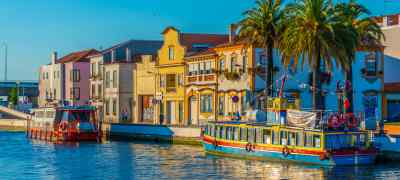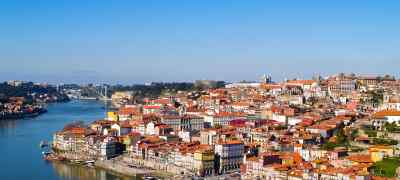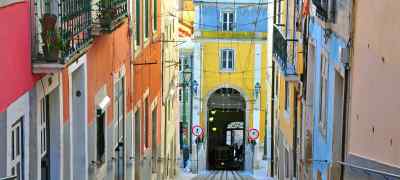By Briana Seftel
A seaside gem set on seven hills, Lisbon is a traveler’s treat. Its combination of fascinating history, fantastic food and wine and welcoming locals make Portugal’s capital a must-see in Europe.
View vacation packages to Lisbon >
What to Know
A hilly city where the Tagus River meets the Atlantic Ocean, Lisbon is a working man’s city with a heart of gold. The city was a trading giant in the 16th century, when Vasco de Gama and Magellan made Portugal a world power. After suffering a devastating earthquake in 1755 and decline in the 19th century, Lisbon has risen again to become one of Europe’s most captivating cities. It’s also Western Europe’s least expensive capital, making a trip here a great value.
When to Go
Nestled along the Iberian Peninsula, Lisbon enjoys some of the best weather in all of Europe. Summers are marked by sunny, warm days while winters barely go below 50F. As with most of Europe, Lisbon’s peak travel season is from June to August, when the weather hits its highest temperatures and festival season begins. If you’d like to experience Lisbon like a local, travel during the shoulder months of April and May or September and October.
How to Get Around
To say Lisbon is a walking city would be an understatement; the city’s steep, hilly lanes make driving nearly impossible! You’ll want to pack comfortable walking shoes and a map to explore the city’s inviting cobbled lanes and grand open squares. If you’re not up for walking, you can always hop on one of the city’s old-fashioned trams or funiculars. Tram 28 is Lisbon’s famous line that weaves through the historic Alfama district, among other picturesque neighborhoods.
Where to Eat
With its proximity to the sea, Lisbon’s cuisine features a lot of seafood caught just minutes from the city center. Sardines, cod, clams and octopus are all common dishes you’ll see on menus, either simply grilled or fried in a light and tasty batter. When it comes to sweets, perhaps no city does them better than Lisbon. A trip here wouldn’t be complete without trying the pastel de nata, an egg custard tart dusted with cinnamon and sugar.
- Pasteis de Belem R. de Belém 84-92, 1300-085 Phone: +351 21 363 7423
- Mercado Da Ribeira (Time Out Market) 481, Av. 24 de Julho, 1200-109 Phone: +351 21 346 1199
- Piteu Da Graca Largo da Graça 95-96, 1170-165 Phone: +351 21 887 1067
- Cerevejaria Ramiro Av. Almirante Reis nº1 - H, 1150-007 Phone: +351 21 885 1024
- Manteigaria Rua do Loreto 2, 1200-108 Phone: +351 21 347 1492
- Taberna Da Rua Das Flores Rua das Flores 103, 1200-015 Phone: +351 21 347 9418
- Restaurante Ponte Final R. do Ginjal 72 Phone: +351 21 276 0743
What to See
Jeronimos Monastery
Built by King Manuel I in 1502, Jeronimos Monastery is one of the most impressive sites in Portugal. Its unique Manueline architecture (named after the king) reflects the wealth during the Age of Discovery, and it’s here where Vasco de Gama is buried. While entrance to the church is free, you will want to pay for admission to the cloisters, considered among the most beautiful in the world. Also on site is the National Museum of Archaeology.
Sao Jorge Castle
For the best views over Lisbon, head to the imposing Sao Jorge Castle. Dating back to the 11th century, the castle become a royal palace in the 12th century but fell into ruins after the king moved. Surrounded by a peaceful park, the castle offers superb views of the old city, Tagus Estuary and Ponte 25 de Abril suspension bridge.
Alfama
The Alfama district is Lisbon’s oldest area dating back to over 1,000 years old when it was ruled by the Moors. Located between Sao Jorge Castle and the Tagus river, its Moorish flair can still be seen in its tangled lanes and pastel-hued buildings. Hop on a tram or cozy up in a tavern to experience this atmospheric, working class neighborhood.
Belem Tower
This medieval defense tower is one of Lisbon’s many waterfront landmarks. Built by King Manuel, the tower protected Lisbon’s harbor and features an ornate design similar to that of Jeronimos Monastery. It was the last sight sailors saw before embarking on their voyages to discover new worlds, and the first when they returned.
Rossio Square
Rossio Square is the heart of Lisbon where locals and visitors come to stroll or stop for a drink at one of the many outdoor cafes. In the 19th century, the square was paved with cobblestones in wave patterns, making it one of the most Instagram worthy places in the city.
Tips and Tricks
Pop into a tavern in Alfama to hear fado, the traditional music of Portugal.
Lisbon’s 1.5-mile long suspension bridge, one of the longest in the world, closely resembles San Francisco’s famous red bridge.
Order the locals’ favorite aperitif, a port tonic, which is white port wine mixed with tonic and served with a slice of lime.
Download the Lisbon Street Art app to discover Lisbon’s vibrant street art scene.
Day Trips
Sintra
Sinta is one of Europe’s most romantic cities and just a 40-minute train ride from central Lisbon. Wandering through its streets is like stepping into a real-life fairy tale. Explore the historic center, then make your way up to the hilltop Pena Palace, a 19th-century palace built by King Ferdinand in a colorful and whimsical Romanticism style of architecture.
Obidos
Obidos is Portugal’s prettiest medieval village just one hour by car from Lisbon. Noted for its white washed buildings and cobbled lanes, it’s best to leave your map behind when exploring this town. A popular day trip especially in the summer, Obidos draws visitors for its festivals throughout the year like the Medieval Fair and the International Chocolate Festival.
Cascais
If you’re looking for sun and surf, head just 40 minutes to the seaside town of Cascais. A surfer’s paradise, Cascais is the perfect embodiment of Portugal’s seafaring history. Lay out on Praia da Rainha beach, take a photo of Boca do Inferno (hell’s mouth) cave and do some shopping at Mercado da Vila market.
Go here for more day trips from Lisbon!
















